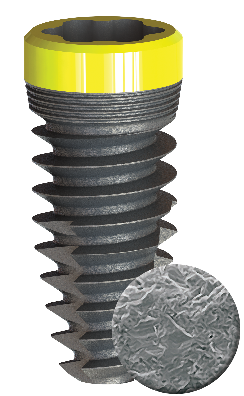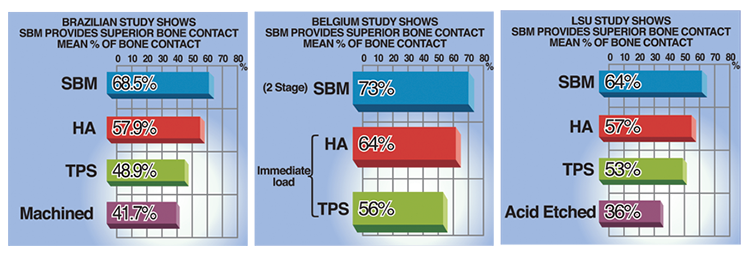Surface Treatment & Anodization
Surface Treatment
 SBM – Soluble Blast Media
SBM – Soluble Blast Media
Case Studies vs. other common practices, ie. Machined, Titanium Spray, Hydroxylapatite Coating, Acid Etched
The surface of I.D.I. Dental Implants have a highly bio-compatible roughness that is excellent for osseointegration. Our implants are blasted with a resorbable SBM and then the blasted medical residue is removed from the implant (ASTM F86-4 standard). The surface of our implants is treated by one of the most experienced companies in the world. Many other implant companies are also moving towards this surface because it has a very predictable roughness and does not require heating the parts at very high temperatures (such as plasma spraying or HA coating).
We are convinced that with all the additional benefits found in our dental implants, you will achieve much better results at the lowest cost.
I.D.I. Dental Implants have demonstrated high success rates (up to 99%). Our as clinicians depends on the quality of our products. You can rapidly grow your practice with the IDI Dental Implant System.
Case Study:
Histomorphometric analysis of the bone-implant contact obtained with 4 different implant surface treatments placed side by side in the dog mandible.
Int J Oral Maxillofac Implants 2002 May-Jun; 17(3):377-83 (ISSN: 0882-2786)
Novaes AB; Souza SL; de Oliveira PT; Souza AM
School of Dentistry of Ribeirao Preto, University of Sao Paulo, Brazil.
novaesjr@forp.usp.br
PURPOSE: The different implant systems available today present several types of surface treatment, with the aim of optimization of bone-implant contact. This study compared 4 different types of implant surfaces. MATERIALS AND METHODS: The first, second, third, and fourth mandibular premolars were extracted from 5 young adult mongrel male dogs. Ninety days after removal, four 3.75-mm-diameter, 10-mm-long screw-type implants (Paragon) were placed with different surface treatments in mandibular hemiarches. The dogs received 2 implants of each of the following surface treatments: smooth (machined), titanium plasma spray (TPS), hydroxyapatite coating (HA), and sandblasting with soluble particles (SBM). The implants were maintained unloaded for 90 days. After this period, the animals were sacrificed, and the hemimandibles were extracted and histologically processed to obtain non-decalcified sections. Two longitudinal ground sections were made for each implant and analyzed under light microscopy coupled to a computerized system for histomorphometry. RESULTS: The following means were obtained for bone-implant contact percentage: machined = 41.7%, TPS = 48.9%, HA = 57.9%, and SBM = 68.5%. DISCUSSION: The means for all treatments that added roughness to the implant surface were numerically superior to the mean found for the machined surface. However, this difference was statistically significant only between groups SBM and machined (Tukey test, P < .05). CONCLUSIONS: The SBM-treated surface provided a greater bone-implant contact than a machined surface after 90 days without loading in this model.

Anodization III
Our implants are coated with an Type III Anodize which serves as a multi-purpose benefit for aesthetics, identification and functionality for each implant system. The vibrant colors are to indicate industry standard size specification and system type by color code.
The anodize creates a mirror-like, smooth finish that serves as an optimal surface for implant cleaning and maintenance. Providing approximately 1.0 – 1.5mm smooth collar allows patients the ability to avoid unnecessary and excessive plaque accumulation and bone loss in case of implant exposure.
Quirynen et al., 1993: “implant abutments with rough surfaces tended to accumulate 25 times mores plaque than with smooth surfaces”
Although the surface of the implant is coated with a thin-coat anodize, the surface still retains a micro-porous structure allowing for osseointegration to be achievable along the entire dental implant.











